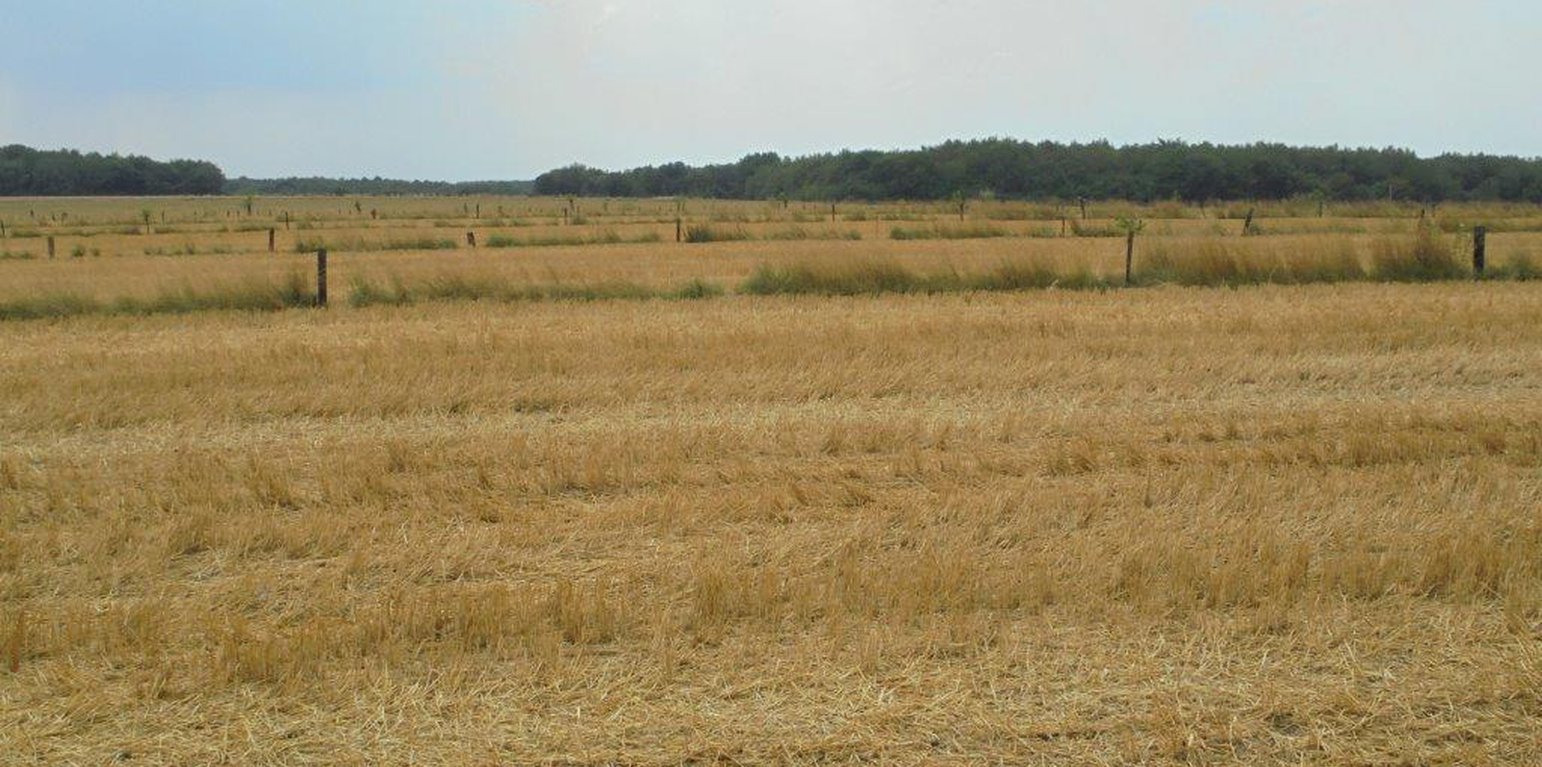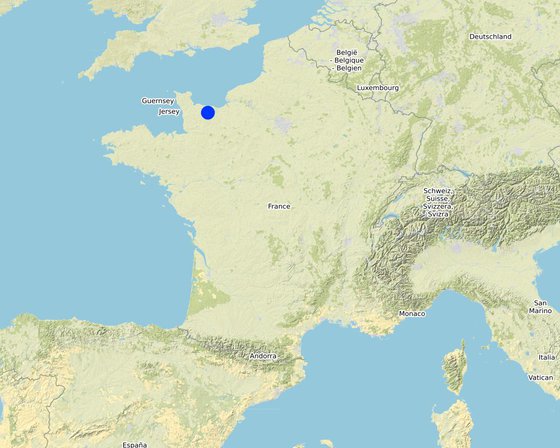



Agroforestry, that is the incorporation of trees into agriculture, is a traditional land management practice in Normandy using apple trees inter-grazed by cows on pasture. However, between 1960 and 2000, the restructuring of agricultural land, and technical and technological developments, have led to the disappearance of agroforestry in Normandy. Since the beginning of the 21 century, the integration of trees into the system has started to be reintroduced, not only in grassland systems, but also in crop fields.
The integration of trees into the system is effective for countering:
- Biological degradation: by enhancing biodiversity though improved refuge for insects and birds, providing food for them, breeding opportunities and connectivity corridors across the landscape. This leads to greater biological regulation of crop pests among other benefits.
- Climate related stress: both at the local level (decrease of wind speeds, reduction of evapotranspiration, shade for animals) and at the global level (carbon storage, substitution of fossil energies by renewable energy).
- Water degradation: through the qualitative and quantitative regulation of water at the watershed scale as a benefit of improved rainfall infiltration and less fertilizer lost in runoff.
- Soil erosion by water and chemical deterioration: through the conservation of soils with reduced runoff.
- Soil erosion by wind: through the protection of exposed areas.
and:
- Providing benefits through beautification of the living environment.
As part of the agroforestry SLM technology, trees are planted on grassed strips which are 24 to 30 m apart within the field of cereals. Trees are spaced 8 to 10 m within the strips. This configuration has been adapted to allow mechanized agriculture. The main tree species used are Quercus, Sorbus, Tilia, Prunus and Robinia. Land users, with some support from the local community, financed the re-introduction of agroforestry into Normandy. Soil was prepared using machinery (single line ploughing), mulch was applied and tree seedlings were protected against wild animals.
Despite these financial and management benefits. the SLM technology has not yet been taken up widely. Therefore, the aim is to promote better adoption of agroforestry practices by Normandy farmers. This is becoming more important as the use of external inputs (e.g. fertilizers and pesticides) is increasingly expensive for both farmers and society - and the introduction of agroforestry can both help reduce these costs with more natural pest control and less runoff of fertilisers from the fields.
The compilation of this SLM is a part of the European Interreg project FABulous Farmers which aims to reduce the reliance on external inputs by encouraging the use of methods and interventions that increase the farm’s Functional AgroBiodiversity (FAB). Visit www.fabulousfarmers.eu and www.nweurope.eu/Fabulous-Farmers for more information.

ສະຖານທີ່: Normandy, ຝຣັ່ງ
ຈໍານວນ ພື້ນທີ່ ທີ່ໃຊ້ ເຕັກໂນໂລຢີ ທີ່ໄດ້ວິເຄາະ: ພື້ນທີ່ດຽວ
ການແຜ່ກະຈາຍຂອງເຕັກໂນໂລຢີ: ນໍາໃຊ້ໃນຈຸດສະເພາະ / ແນໃສ່ນໍາໃຊ້ໃນພື້ນທີ່ຂະໜາດນ້ອຍ
ຢູ່ໃນເຂດປ່າສະຫງວນທີ່ບໍ?: ບໍ່ແມ່ນ
ວັນທີຂອງການປະຕິບັດ: 2017; ຕໍ່າກວ່າ 10 ປີ ຜ່ານມາ (ມາເຖິງປະຈຸບັນ)
ປະເພດຂອງການນໍາສະເໜີ









| ລະບຸ ປັດໃຈ ນໍາເຂົ້າ ໃນການຜະລີດ | ຫົວໜ່ວຍ | ປະລິມານ | ຕົ້ນທຶນ ຕໍ່ຫົວໜ່ວຍ (€) | ຕົ້ນທຶນທັງໝົດ ຂອງປັດໃຈຂາເຂົ້າ ໃນການຜະລິດ (€) | % ຂອງຕົ້ນທຶນທັງໝົດ ທີ່ຜູ້ນໍາໃຊ້ທີ່ດິນ ໃຊ້ຈ່າຍເອງ |
| ແຮງງານ | |||||
| Design & layout of planting | days | 0.5 | 120.0 | 60.0 | 100.0 |
| Surface preparation (clearing & harowing) | days | 0.1 | 120.0 | 12.0 | 100.0 |
| Mulch application | days | 0.2 | 120.0 | 24.0 | 100.0 |
| Planting | days | 0.5 | 120.0 | 60.0 | 100.0 |
| ອຸປະກອນ | |||||
| Tractor with harow & Plough | days | 0.3 | 50.0 | 15.0 | 100.0 |
| ວັດສະດຸໃນການປູກ | |||||
| Tree whips | piece/ha | 30.0 | 3.0 | 90.0 | 20.0 |
| Mulch | piece/ha | 30.0 | 2.0 | 60.0 | 20.0 |
| ວັດສະດຸກໍ່ສ້າງ | |||||
| Base spiral protection | piece/ha | 30.0 | 2.0 | 60.0 | 20.0 |
| ຕົ້ນທຶນທັງໝົດ ໃນການຈັດຕັ້ງປະຕິບັດ ເຕັກໂນໂລຢີ | 381.0 | ||||
| ຄ່າໃຊ້ຈ່າຍທັງໝົດ ສຳລັບການສ້າງຕັ້ງເຕັກໂນໂລຢີ ເປັນສະກຸນເງີນໂດລາ | 423.33 | ||||
| ລະບຸ ປັດໃຈ ນໍາເຂົ້າ ໃນການຜະລີດ | ຫົວໜ່ວຍ | ປະລິມານ | ຕົ້ນທຶນ ຕໍ່ຫົວໜ່ວຍ (€) | ຕົ້ນທຶນທັງໝົດ ຂອງປັດໃຈຂາເຂົ້າ ໃນການຜະລິດ (€) | % ຂອງຕົ້ນທຶນທັງໝົດ ທີ່ຜູ້ນໍາໃຊ້ທີ່ດິນ ໃຊ້ຈ່າຍເອງ |
| ແຮງງານ | |||||
| Tree pruning | days | 2.0 | 120.0 | 240.0 | 100.0 |
| Grass mowing | days | 1.0 | 120.0 | 120.0 | 100.0 |
| ອຸປະກອນ | |||||
| Tractor & mower | days | 1.0 | 50.0 | 50.0 | 100.0 |
| ຕົ້ນທຶນທັງໝົດ ທີ່ໃຊ້ໃນການບໍາລຸງຮັກສາ ເຕັກໂນໂລຢີ | 410.0 | ||||
| ຄ່າໃຊ້ຈ່າຍທັງໝົດ ສຳລັບການບົວລະບັດຮກສາເຕັກໂນໂລຢີ ເປັນສະກຸນເງີນໂດລາ | 455.56 | ||||
Less land available for cropping
No change seen
Wood produce now integrated
Wood product added
Tree lines set for as much ease of mechanical use as possible, yet still does disrupt ease of crop management
Loss of crop area, yet some less inputs required (i.e. pesticide)
Wood and cereal crop combined
Tree maintenence takes longer than when working a single crop field
Improved skill set with learning & training in agroforestry
Trees act as buffer strips for better quality water with less run-off
Trees act as buffer strips for better quality water with less run-off
Improved soil infiltration
Improved soil infiltration and moisture capacity
Trees act as buffer strips for better quality soil with less run-off erosion
Trees act as buffer strips for better quality soil with less run-off erosion for bette accumlation
Stips of trees require less passes of tractor in field
Trees can use deeper nutrient stores
Increased carbon below ground with larger tree rooting systems
Diversity of vegetation between tree grass strips
Trees hold more above ground C
With trees and diversity of vegetation between tree grass strips
Natural pest control through habitat for predators with trees
More space for habitat
Natural pest control through habitat for predators with trees
Increased infiltration reduces flood impacts
Improvements in soil moisture capacity
Trees act as shelter belts for crops
Less and cleaner water run off due to buffer strips
Shelter belt reduces wind erosion